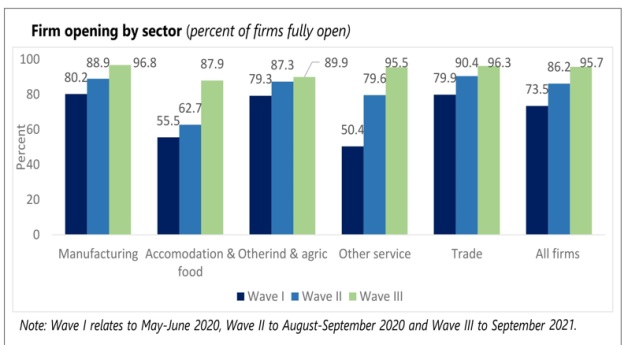The Business Tracker survey has revealed that the country’s manufacturing and trade sectors, which were hit hard by the pandemic, have almost fully recovered as both saw an appreciable increase in activities during the third wave of the pandemic (from January to September), thereby inspiring hope that the economy is getting back on track.
According to data published by the Ghana Statistical Services (GSS), the manufacturing sector’s recovery during the third wave of coronavirus disease that swept the country has hit 96.9 percent; the highest recovery in all sectors of the economy. This is higher than the 80.2 percent and 88.9 percent recovery recorded in the first and second waves of the pandemic respectively.
With regard to employment, the sector also saw a sharp decline in the number of staff that have reduced wages. Only 2.9 percent of the sampled companies (4,858) responded that they still have workers on reduced wages after the third wave of the pandemic, compared with 12.2 percent and 7.7 percent respectively in the two previous waves.
Furthermore, the manufacturing sector also experienced a 37.8 percentage points increase in sales within the period under discussion – an astronomic jump from the 7.7 percent and the 6.9 percent in the first and second waves, all pointing to the fact that recovery in the sector has significantly improved.
Trade
The same trend is also observed in the trade sector, as it saw 96.3 percent of firms fully recovered; up from the 79.9 percent and 90.4 percent recorded in the previous two waves.
It also saw the number of workers who have had their wages cut decrease to 2.5 percent during the third wave of the pandemic from the 20 percent and 13.1 percent recorded in the first and second waves.
Then, with regard to increase in sales, the trades sector recorded the highest performance of 46 percent during the third wave; up from the 10 percent and 7.4 percent seen in the first and second waves.
Government support crucial
The report adds that there is a correlation between government support and recovery, as firms which received some stimulus experienced more growth in sales than those that did not.
Thus, firms with government support experienced 11.5 percent higher sales than firms that did not receive any government support. A breakdown by sector of firms and size revealed that the impact was not felt across all types of firms.
Manufacturing, Accommodation and Food were not the only sectors wherein firms that received government support experienced higher sales. Higher sales were recorded in firms in manufacturing sector (26.5 percent), and accommodation and food sector (40.7 percent). Small-size firms with support recorded a 22 percent higher sale.
“The survey results show that firms continually need support both in the short and medium terms. Firms have been consistent with their request to put in measures that will support their businesses. Waves I and II saw loans with subsidised interest rates/cash transfers, and deferral of rent, mortgages or utilities as the three top desired polices of firms.
“The story, however, changed a little in Wave III – when the third-most desired polices of firms moved from being deferral of rent, mortgage or utilities to accessing new credit. However, firms still maintained their demand for the other two most-needed policies, with a slight reduction for loans with subsidised interest rates.
“Just like previous waves, firms continue to desire policies that help them alleviate cash constraints and stay in business. Even though Waves I and II described loans with subsidised interest rates, cash transfer and deferral of rent as the top three most desired polices of firms, in the third wave more firms report access to new credit as a desired policy,” the report states.
Source: thebftonline.com





